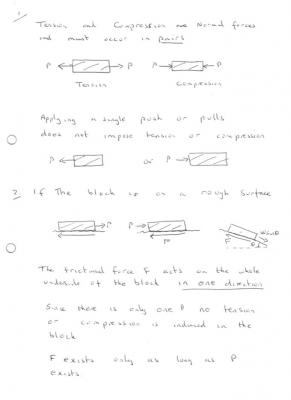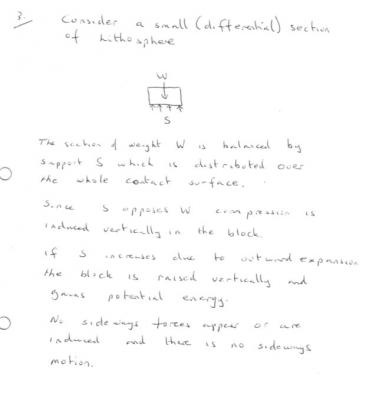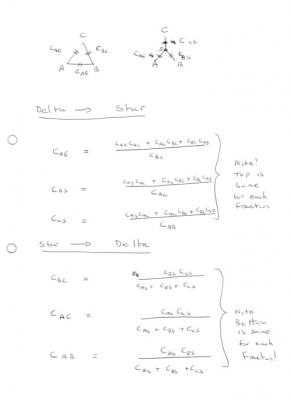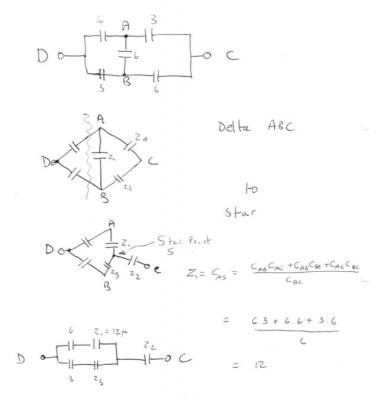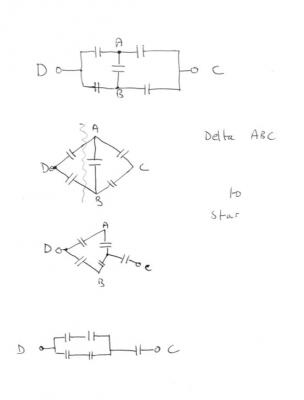-
Posts
17639 -
Joined
-
Last visited
-
Days Won
93
Content Type
Profiles
Forums
Events
Everything posted by studiot
-
Division by zero???? Responses, they do not mean the same thing. 1) It can't be done. 2) It is forbidden. 3) It is undefined. So what should the questioner think? Should he stamp his foot like a petulent schoolboy? Should he ask why can't it be done or is it not defined? 1) Perhaps it is like finding a helium atom with twentry protons, that can't be done because atom with twenty protons would be something else, not helium. 2) If it is necessary to forbid it it implies that it is possible, but some authority does not want the procedure performed. 3) Why is it undefined? Well perhaps because the responder does not know the answer, or perhaps because he knows a great many things it is not.
-
Not sure what you want here, tell us more about your interest and the level you expect to find. You may find looking up the subjects of Engineering Mechanics Mechanics of Machines Contact Mechanics Engineering Tribology Acceleration Diagrams Engineering Fluid Mechanics Transport Phenonema Heat engines But you will find differential equations pretty common. Two books come to mind Mathematical Modelling by Berry and Houston An introduction to the subject taking you from upper high school into university. The Mathematical Mechanics by Mark Levi. A delightful book where the author sets out to use mechanics to provee mathematical theorems and achieves a useful blend of mechanics and maths.
-
We've been through this before, and I asked for a force diagram showing (proving) this statement. Since it was not forthcoming, I started to build up to this situation with my diagrams in post 178, that you seem to want to ignore. I started with the simplest possible. Your scenario is more complicated. In force terms it is: Take a block, restrain one end, and apply a tangential force to one surface only acting away from the fixed end. This will induce shear, not tension in the block.
-
Tension forces can only occur in pairs see item 1 post 178. So what pulls the other end?
-
Are we having two conversations here? You seem to be replying to alternate posts of mine?
-
How can the surface tear unless the circumference increases or something digs into it? Something causes this, it does not happen by itself. In particular the plates are observed to move in human timescales. What moves them?
-
The only force that holds the plate onto the mantle is it's weight ie gravity. If the mantle expands in radius it will also expand in circumference, but the plate will not expand, it will be moved to a large edit larger radius, thereby gaining gravitational potential energy. In particular it will not be dragged sideways by such an event. This is shown in the first three sketch sheets. Do you agree?
-
Mathematically distance and length are different, although the distinction is more blurred in Physics, this thread was posted in the Maths section. The original question is about length and many posters (myself included) have been disregarding the distinction. I think it is time to set that straight. Distance refers to how close (or far) apart two objects are. It is defined only by the endpoints and makes no reference to or provides any information about the points in between, if indeed there are any. For instance in statistics we often measure how close one set of numbers is to another and compute the 'distance' between the sets. There are no intermediate points in this case. Length, on the other hand, includes both the endpoints and all the points in between. This is best exemplified by considering intervals on sets of real numbers. An interval consists of all the numbers (x) satisfying one of the following conditions For any real numbers a, b with [math]a < b[/math] [math]a \le x \le b[/math] [math]a < x < b[/math] [math]a < x \le b[/math] [math]a \le x < b[/math] [math]x \le a[/math] [math]x < a[/math] [math]x \ge a[/math] [math]x > a[/math] For the first four the length of the interval is defined as the real number b-a. This can be seen to be positive definite when a is not equal to b and zero when a = b
-
Yes I think the proposed mechanism is induction heating of the core due to its motion through a magnetic field which in turn causes expansion...etc..... I don't know about this. I am just trying to get the mechanics of any expansion straight.
-
But he didn't say that. He said the mantle expands. Anyway I am assuming the mantle expands, which means a (small) increase in radius. As a result the lithosphere is raised further from the centre and experiences a gain of potential energy. Let us explore the mechanics of this. Here are some sketches to start with.
-
I am not interested John Carter stories. edit: except as entertainment. I thought arc's theory depended upon the asthenosphere radius increasing (and decreasing) by small amounts. Arc please clarify before I do these sketches.
-
Forgive me but I have taken this statement to mean that your thesis requires the earth to expand, albeit ever so slightly, throughout my reading of this thread. Please clarify.
-
That would rather depend upon the Reynold's number of the motion, which in turn is influenced by the viscoscity of the fluid and the speed and size of the spinner. It is quite possible that you would get what is known as a Rankine vortex where there is a small rotational core aound the spinner and the rest of the fluid executes irrotational circular flow around this, rather like a line vortex, which is irrotational.
-
This should be in homework I think. However you have shown your efforts so can you tell me what theta is? There are two separate trigonometric entities. One is the angle between the field and the coil, the other is sin (t) or cos (t), where t is time not angle. That is the applied field strength (not direction) varies with time according to B = B0 sin(wt) Does this help.
-
I am sorry arc, upon re reading your paragraph I did indeed misunderstand. Thank you for correcting that part. I was just trying to get you to wait until I have time to make the sketches sufficiently presentable, to avoid abortive work. You are still not quite right about tension and tension cracks. Tension cracks only occur in sufficiently brittle materials. Rigidity is a response to bending and a function of the size and shape of the object and the disposition of the loads. This is unlike tension (brittle) cracking which is purely a function of stress intensity.
-
Surely this is an antiscientific approach? An appropriate scientific approach would be to say I observe these effects. They can be explained by mechanisms A, B or C (etc). I also observe these other effects, contrary to mechanisms A, B, C etc. Therefore I conclude that there must be another mechanism in play that I have not listed. Did Lord Kelvin not make this mistake? http://www.phy.duke.edu/~hsg/134/lectures/ages-of-earth-sun.pdf I do not know whethere I support or disagree with Arc's hypothesis, it is bold, large and possibly revolutionary. Arc did, however, start out by saying there were areas in which he lacks expertise and requesting help. That suggests to me a necessary humility his opponents seem to lack. If he is correct would we not be proud to say, we had a (very small) hand in that? And surely that is one important function of this forum.
-
I'm sorry this does not make sense. You start the paragraph by saying the mantle is not rigid, but flexible. You end the paragraph by claiming that the mantle must be subect to a 'stress relieving fracture'. Surely these two statements oppose each other? I am worried that plus the the rest of the paragraph suggests some unfamiliarity with mechanics, that I want to help you address. So let me put up my sketches for discussion. I promised some sketches (sorry I can't match your skill or resources with the colour diagrams) but they will suffice.
-
Since the transformation is usually reported in terms of resistance or impedance, and others might be interested in capacitance (or admittance) I have written these transformations out in full. The notation is that the capacitance between the nodes is given by the subscript eg the capacitance between B and C is CBC which only appears in the Delta configuration In the star configuration all the capacitances are between an individual node and the star point (S). So the star has one more node than the delta.
-
No, as soon as the car wheels leave the ground the car has no traction cannot accelerate.
-
If we label the star point as S and compute the capacitances from the delta nodes A, B and C to S using the formulae [math]{C_{AS}} = \frac{{{C_{AB}}{C_{AC}} + {C_{AB}}{C_{BC}} + {C_{AC}}{C_{BC}}}}{{{C_{BC}}}}[/math] etc We can easily reduce and compute the equivalent capacitance of the network. I have amended my sketch to show that the star capacitance from A to S CAS is 12 microfarads. You should be able to complete the job from here.
-
I appreciate what you say, but that does not explain why or how a plate is held stationary in a trench or how it gets there in the first place. I am trying to avoid being involved in the squabble over the 'theory of theories' that seems to be running in this thread and simply accept as a premise your theory that the mantle slowly expands and contracts slightly (without asking how or why) and see if the laws of mechanics applied to loosly attached 'plates' leads to the activities we observe. In order to communcate this using the correct terminoliogy is important. Further the material at even reasonable depth is under such a large compressive force that our usual surface mechanics do not apply directly. Often it is a question of partial unloading, just as with prestressed structures. I think a few sketches of the mechanics of plates on expanding/contracting surfaces are in order. I am really trying to help you get your story straight here for the court of inquiry
-
Professor Trachtenberg was imprisoned by the Nazis and came up with schemes of mental arithmetic to keep him sane. It is known as the Trachtenberg system (you should) look it up. The instruction to multiply any number by 11 for instance is Write down the last digit. Add successive pairs of neighbours to successively obtain the next digit to the left and so on write doen the last digit. So 11 x 11 write down last digit =1 1 next leftmost digit is 1+1 = 2 21 write down rightmost digit =1 11 x 11 = 121 you can see the pattern extended to 111 etc in your listing.
-
Ok, I agree with your first transformation, and does the term delta - star (the americans call it wye -mesh) transformation mean anything? It is the next step on in network theory from series and parallel, but still does not require any voltages or current to be considered. I have developed your diagram further to show the delta to the right of the wiggly line and labelled the vertices to keep track in the transformation to a star. You require the capacitance between D and C. C is one vertex of the delta, A and B are the others. Finally I have redrawn the transformed circuit to show a parallel combination of two pairs of series capacitors, in series with another capacitor. You can therefore analyse this network purely by formule involving capacitor combinations. Incidentally since it is possible to derive the transformation solely from consideration of series and parallel combinations it is not true to say that http://www.electronics-tutorials.ws/dccircuits/dcp_10.html
-
Did you find this in Trachtenberg?



